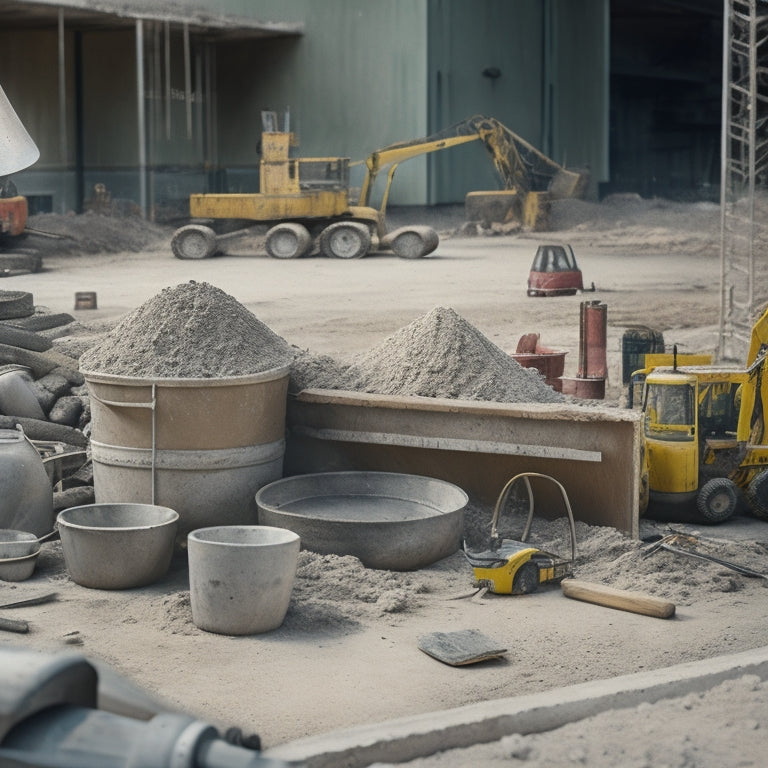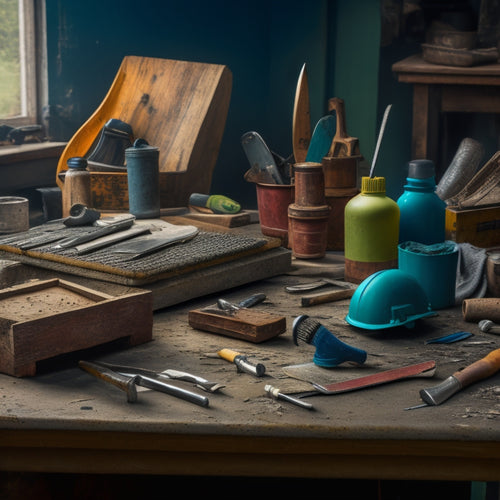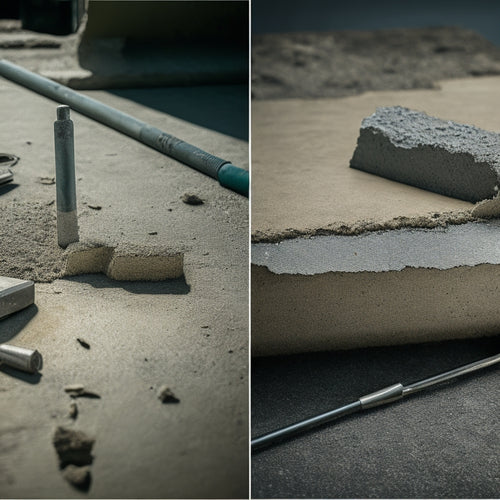
Concrete Construction Tools You Need to Buy
Share
You'll need to invest in a range of specialized tools to guarantee the success of your concrete construction project. Start with essential mixing equipment like drum mixers and pan mixers, then move on to block laying and handling tools like tampers, grips, and clamps. Don't forget concrete finishing and smoothening tools, safety gear like hard hats and steel-toed boots, and measuring and leveling devices like laser levels and spirit levels. Additionally, you'll need concrete cutting and drilling tools, compaction and vibrating tools, and equipment for curing, sealing, and cleaning. With the right tools, you'll be well on your way to a successful project - and understanding the specifics of each will take your work to the next level.
Key Takeaways
• Invest in a concrete mixer, such as a drum, pan, or twin-shaft mixer, suitable for your project size and requirements.
• Purchase tamping tools, block grips, and clamps for efficient block laying and handling, ensuring accurate placement and structural integrity.
• Acquire specialized finishing tools, including edgers, floats, and power trowels, for achieving high-quality, smooth surfaces.
• Prioritize safety gear, such as hard hats, protective eyewear, and steel-toed boots, to protect workers from job site hazards.
• Consider essential measuring and leveling devices, like high-quality tape measures and laser levels, for accurate project execution and alignment.
Essential Concrete Mixing Equipment
You'll frequently find that a concrete mixer is the cornerstone of any concrete construction project, as it enables you to combine cement, water, and aggregate into a uniform, workable mix. This essential tool allows you to achieve the perfect blend, which is critical for ensuring the structural integrity of your concrete structure.
When it comes to mixing techniques, you'll need to decide between batch mixing and continuous mixing. Batch mixing involves mixing small quantities of concrete at a time, while continuous mixing involves mixing large quantities in a single, uninterrupted process.
You'll also need to choose the right mixer type for your project. There are several options available, including drum mixers, pan mixers, and twin-shaft mixers. Drum mixers are ideal for small to medium-sized projects, while pan mixers are better suited for large-scale projects. Twin-shaft mixers, on the other hand, offer high-speed mixing and are often used in high-volume applications.
Block Laying and Handling Tools
When constructing concrete blocks, having the right block laying and handling tools is vital for achieving accurate placement, guaranteeing structural integrity, and maximizing productivity. You'll need to invest in high-quality tools that can withstand the demands of block handling and masonry work.
Here are some essential block laying and handling tools you'll need to add to your collection:
-
Tamping tools: These include hand tampers, plate compactors, and jumping jacks that help settle and compact the block courses, guaranteeing a solid foundation.
-
Block grips and clamps: These tools provide a secure hold on the blocks, allowing you to lift, move, and place them with precision and control.
-
Leveling and alignment tools: These include spirit levels, laser levels, and straightedges that help you achieve accurate block placement and guarantee the structure is plumb and level.
With these tools, you'll be able to work efficiently and effectively, producing high-quality concrete block structures that meet your clients' expectations.
Concrete Finishing and Smoothening
Finishing and smoothening concrete surfaces requires specialized tools to achieve a high-quality, visually appealing finish that meets project specifications and client expectations.
You'll need to invest in a range of tools to accomplish this, including tamping tools, edgers, and floats. Tamping tools, such as bull floats and darbies, help to remove excess water and air from the surface, while edgers are used to create a clean, defined edge. Floats, on the other hand, are used to smooth out the surface, removing any imperfections and creating a uniform finish.
When it comes to finishing techniques, you'll need to decide which method is best suited to your project. Do you need a high-gloss finish, or a more textured, broom-finished look? Different smoothing methods will achieve different results, so it's crucial to choose the right tools for the job.
For example, a power trowel is ideal for large, flat areas, while a hand trowel is better suited to smaller, more intricate spaces. By investing in the right tools and mastering various finishing techniques and smoothing methods, you'll be able to achieve a professional-looking finish that exceeds client expectations.
Safety Gear for Concrete Workers
As you step onto a concrete construction site, you'll need to gear up with the right safety equipment to protect yourself from hazards.
You're responsible for ensuring your own safety, so it's crucial to wear the correct gear, including hard hats and helmets, protective eyewear, and steel-toed boots.
Hard Hats and Helmets
You wear hard hats and helmets to protect your head from falling objects, debris, and electrical hazards on concrete construction sites. As a concrete worker, you're exposed to various risks that can cause serious head injuries or even fatalities. That's why wearing a hard hat or helmet isn't just a recommendation, but a necessity.
When it comes to hard hat regulations, you need to ascertain that your helmet meets the standards set by organizations such as OSHA and ANSI.
Here are some key factors to contemplate:
-
Certification: Look for helmets that are certified by reputable organizations, ensuring they meet strict safety standards.
-
Inspection: Regularly inspect your hard hat for signs of damage, wear, or expiration, and replace it as needed.
-
Proper Fit: Ensure your hard hat fits snugly and comfortably, allowing for clear visibility and hearing.
Protective Eye Wear
Wearing protective eyewear is a critical aspect of concrete construction, as it shields your eyes from flying debris, chemical splashes, and other hazardous materials that can cause serious eye injuries or blindness. You should invest in high-quality protective eyewear that meets or exceeds industry standards.
There are various types of protective eyewear to choose from, including safety glasses, goggles, and face shields. Each type offers unique protection features, so select the one that best suits your specific work requirements.
When selecting protective eyewear, consider the lens coatings. Anti-fog coatings prevent fogging, while scratch-resistant coatings guarantee durability. You may also opt for lenses with UV protection to shield your eyes from harmful ultraviolet rays.
Some protective eyewear models come with prescription lenses, making them suitable for workers who wear corrective glasses. Remember to choose protective eyewear that fits comfortably and securely, allowing you to focus on your work without distractions.
Steel-Toed Boots
Steel-toed boots, an essential component of your personal protective equipment, provide a robust barrier between your feet and the harsh concrete construction environment. As a concrete worker, you're constantly exposed to heavy objects, sharp edges, and harsh chemicals that can cause serious foot injuries. That's why it's vital to invest in high-quality steel-toed boots that meet stringent safety standards.
When selecting steel-toed footwear, consider the following key factors:
-
Slip-resistance: Look for boots with slip-resistant soles to prevent falls on oily or wet surfaces.
-
Ankle support: Choose boots with high ankle collars to provide additional protection from twists and sprains.
-
Breathability: Opt for boots with breathable materials to keep your feet cool and dry during long work hours.
Measuring and Leveling Devices
Accurate measurements and precise leveling are crucial in concrete construction, and that's why measuring and leveling devices are key tools in every contractor's arsenal. You'll need devices that provide precise readings and guarantee your structures are perfectly aligned.
For measuring, you can't go wrong with a high-quality tape measure. Look for one with a sturdy design, clear markings, and a long, durable tape that can withstand the rigors of the job site. You'll use it to measure everything from concrete slabs to formwork, so it's important to get it right.
When it comes to leveling, laser levels are the way to go. These advanced tools project a precise level line or dot, assuring your concrete pours are perfectly horizontal or vertical. They're also great for checking the accuracy of your measurements and identifying any deviations from the plan.
With a laser level, you can be confident that your concrete structures will be level, plumb, and square. By investing in these measuring and leveling devices, you'll be able to tackle even the most complex concrete construction projects with precision and accuracy.
Concrete Cutting and Drilling
You'll need to equip yourself with the right concrete cutting and drilling tools to make precise cuts and holes in concrete, whether you're working on a small repair job or a large-scale construction project. Having the correct tools will save you time, effort, and guarantee a professional finish.
When it comes to concrete cutting, you'll need:
-
Diamond blades designed for your specific saw or grinder, which will provide a clean, accurate cut.
-
A rotary hammer or demolition hammer for heavy-duty demolition and breaking up concrete.
-
Core drills for creating precise, circular holes for pipes, conduits, or other fixtures.
These tools will allow you to tackle various concrete cutting and drilling tasks with confidence.
Diamond blades, for instance, are essential for making precise cuts in concrete, while core drills are perfect for creating holes for pipes or conduits. By investing in these tools, you'll be well-equipped to handle any concrete cutting and drilling task that comes your way.
Compaction and Vibrating Tools
You're about to explore the vital role of compaction and vibrating tools in concrete construction.
You'll discover the importance of selecting the right soil compaction methods for your project, as improper compaction can lead to structural weaknesses.
Next, you'll learn how to control vibration frequency to guarantee effective compaction and prevent damage to surrounding structures.
Soil Compaction Methods
In preparing the soil for concrete construction, compacting the soil is essential to prevent settling or shifting that could compromise the structure's integrity. This is where soil compaction methods come into play.
You need to guarantee the soil density meets the required standards to support the weight of the concrete structure. There are various compaction techniques you can employ to achieve the desired soil density.
Some of the common soil compaction methods include:
-
Mechanical Compaction: This involves using heavy machinery like rollers, compactors, and excavators to compress the soil.
-
Hand Compaction: This method involves using hand tools like rammers, tampers, and plates to compact the soil.
-
Vibratory Compaction: This technique uses vibrating tools to compact the soil, which is especially effective for granular soils.
Vibration Frequency Control
Controlling vibration frequency is essential when using compaction and vibrating tools to achieve ideal soil density and prevent over-compaction, which can lead to soil damage or structure instability. As you work with these tools, you'll need to adjust the vibration frequency to suit different soil types and conditions.
| Tool Type | Vibration Frequency (Hz) | Application |
|---|---|---|
| Hand-held vibrators | 100-150 | Small areas, tight spaces |
| Plate compactors | 150-200 | Medium-sized areas, granular soils |
| Ride-on rollers | 200-250 | Large areas, cohesive soils |
| Soil compactors | 250-300 | Deep soil compaction, heavy loads |
| Vibrating screeds | 300-350 | Concrete finishing, high-frequency vibration |
Concrete Curing and Sealing
After pouring and finishing concrete, it's vital to cure and seal it correctly to achieve the best strength, durability, and appearance. You'll need to invest in the right tools and products to guarantee a successful curing and sealing process.
When it comes to curing techniques, you'll want to take into account the following:
-
Moisture-retentive covers: These help maintain a consistent level of moisture, which is essential for proper curing.
-
Curing compounds: These are applied to the surface of the concrete to prevent moisture loss and promote hydration.
-
Temperature control systems: These systems regulate the temperature of the concrete to optimize the curing process.
In addition to curing techniques, you'll also need to select the right sealing products for your project. These products protect the concrete from environmental elements, enhance its appearance, and make it easier to maintain.
Cleaning and Maintenance Tools
During the lifespan of your concrete structure, you'll need to regularly clean and maintain it to prevent damage and extend its lifespan. A well-maintained concrete structure not only looks better but also lasts longer and requires fewer repairs. To achieve this, you'll need the right cleaning and maintenance tools.
Here are some essential tools you should consider:
| Tool | Description | Purpose |
|---|---|---|
| Pressure Washer | High-pressure water sprayer | Remove dirt, grime, and old sealers |
| Broom or Scraper | Stiff-bristled broom or scraper | Remove loose debris and dirt |
| Acid Cleaner | Acid-based cleaner | Remove stubborn stains and etch concrete |
| Sealant Applicator | Roller or sprayer for sealant | Apply sealant to protect concrete |
| Inspection Kit | Magnifying glass, flashlight, and tape measure | Inspect concrete for damage and defects |
Developing a regular maintenance schedule and using the right cleaning techniques will help you keep your concrete structure in top condition. By investing in these essential tools, you'll be able to clean and maintain your concrete structure with ease, ensuring it remains strong and durable for years to come.
Frequently Asked Questions
What Is the Ideal Concrete Temperature for Pouring and Finishing?
When you're preparing to pour and finish concrete, you need to verify the ideal temperature for best results.
You're aiming for a range between 50°F and 75°F (10°C and 24°C) for ideal curing conditions.
Temperature effects can be significant, as excessive heat can cause rapid setting, while cold temperatures can slow it down.
You'll want to avoid extreme temperatures to achieve a strong, durable finish.
Can I Use Regular Gloves for Concrete Work or Are Special Ones Needed?
You've probably worn gloves to protect your hands from the cold, but concrete work demands more than just warmth.
Imagine handling abrasive, alkaline concrete with regular gloves - it's like trying to hold a greased pig at the county fair. You need special gloves designed for concrete work, offering superior skin protection.
Look for gloves with a waterproof barrier, puncture-resistant materials, and grip-enhancing textures. Don't risk skin irritation or injury; invest in the right glove types for the job.
How Often Should I Lubricate My Concrete Construction Tools?
When it comes to lubricating your tools, you'll want to develop a routine that guarantees peak performance and longevity.
You should lubricate your tools regularly, ideally after every 5-10 uses, depending on the specific tool and usage.
Familiarize yourself with lubrication techniques, such as applying a thin layer of lubricant to moving parts and wiping off excess.
Proper tool maintenance is key to extending the life of your tools and preventing damage.
Are There Any Eco-Friendly Concrete Construction Material Options Available?
You're looking for eco-friendly concrete construction material options. Yes, there are sustainable alternatives available.
You can explore using recycled materials like recycled aggregate, fly ash, and slag cement. These options reduce the carbon footprint of traditional concrete production.
Additionally, consider using supplementary cementitious materials like silica fume and metakaolin. These alternatives not only benefit the environment but also enhance concrete's strength and durability.
Can I Rent Concrete Construction Tools Instead of Buying Them?
You're thinking of renting concrete construction tools? Imagine a parade of equipment marching onto your site, a symphony of machinery humming in harmony.
But let's get down to business. Renting can be a cost-effective alternative to buying, especially for infrequent or one-time projects. Conduct a cost comparison to determine the break-even point.
Rental benefits include reduced upfront costs, minimized storage needs, and access to specialized tools without long-term commitment. Crunch the numbers, and you might just find renting is the way to go.
Conclusion
You've got the list of concrete construction tools you need to buy.
Now, the question is, are you ready to build something that will last?
From essential mixing equipment to concrete curing and sealing, you've got the essentials covered.
Remember, investing in the right tools is vital to guarantee a strong foundation, literally.
Don't compromise on quality, and your concrete structure will be standing tall for years to come.
Related Posts
-

Must-Have Handheld Tools for Concrete Repair
When tackling a concrete repair project, it is crucial to have the right handheld tools to achieve a professional fin...
-

Top Tools for Concrete Adhesion Success
When it comes to concrete adhesion success, you'll need to wield the right tools and techniques to guarantee a strong...
-

Why These Concrete Tools Are Always in Demand
You rely on a set of trusted concrete tools to deliver high-quality results, and it's not surprising - these tools ar...


